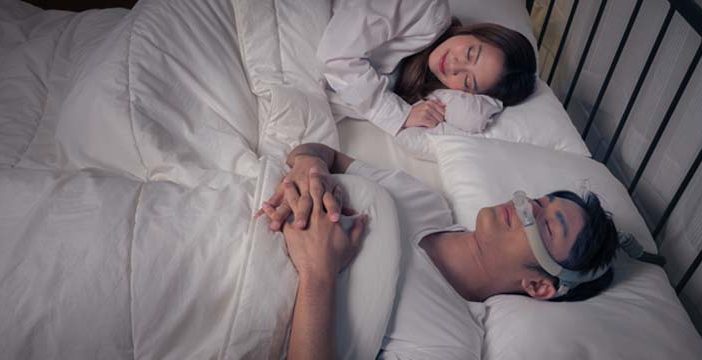
A link between type 2 diabetes and sleep apnea has been demonstrated in the literature. In fact, research suggests that individuals with type 2 diabetes are at an increased risk of developing sleep apnea, and vice versa. Although being overweight or obese is thought to play a role, there have also been studies to demonstrate that the link can exist independent of weight.
What is sleep apnea?
Apnea comes from the Greek word “without breath”. During sleep apnea, breathing stops (apnea) or becomes very shallow (hypopnea). Sometimes the person stops breathing entirely for several seconds, and this can happen hundreds of times a night. A bed partner may hear snoring and then witness gasps followed by a coughing sound, as the person struggles to resume breathing. Both apneas and hypopneas cause sleep arousals. This is when the individual wakes enough to resume breathing but not enough to remember any interruption of sleep. Some arousals simply cause the sleeper to shift into a lighter stage of sleep. In either case, the arousal reduces the quality of sleep.
There are various types of sleep apnea with Obstructive Sleep Apnea (OSA) being the most common. It is the result of a blockage closing the airway during sleep. The other types are Central Sleep Apnea where the brain fails to signal the muscles to breathe, and Mixed Apnea which has characteristics of both.
What is the relationship between type 2 diabetes and sleep apnea?
Higher blood glucose levels can contribute to the severity of sleep apnea. Prevalence of OSA in people with diabetes may be up to 23%, and the prevalence of some form of sleep disordered breathing may be as high as 58%, according to information from the International Diabetes Federation.
Conversely, poor sleep quality and/or sleep deficit can worsen blood sugar control. Sleep apnea induces stress on the body, triggering the release of stress hormones, such as cortisol, which can interfere with insulin function.
Another effect is the change in the hormone leptin, which helps to control appetite. It becomes either deficient or resistant, resulting in overeating. This worsens obesity and the severity of OSA.
Cardiovascular complications. Both OSA and diabetes share another common characteristic: their association with a range of cardiovascular complications such as hypertension, stroke and heart failure.
A never-ending cycle of poor sleep/apnea, obesity and poor glycemic control puts people with diabetes at a great risk of cardiovascular complications. Treating sleep apnea can short-cut the loop and reduce their reinforcing effect on one another.
What is the treatment for sleep apnea?
Lifestyle modifications, including weight loss through diet and exercise, play a central role. A common and effective treatment for obstructive sleep apnea is continuous positive airway pressure (CPAP). CPAP is the first choice treatment for all mild and moderate sleep apnea. It’s the only effective treatment for severe sleep apnea.
The following changes in daily activities or habits can enhance the treatment effect from CPAP, even in people with severe sleep apnea.
- Avoid alcohol and medicines that make you sleepy. They make it harder for your throat to stay open while you sleep.
- Lose weight if you’re overweight or obese. Even a little weight loss can improve your symptoms.
- Sleep on your side instead of your back to help keep your throat open. You can sleep with special pillows or shirts that prevent you from sleeping on your back.
- If you smoke, quit. Talk with your health care providers about programs and products that can help you quit smoking.
Talk to your diabetes care team and your health care provider if you have symptoms of poor sleep. A good night’s sleep curbs appetite and leaving you feeling energetic. It may be the missing link in your diabetes management.



